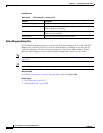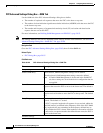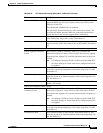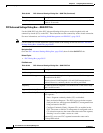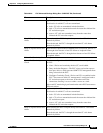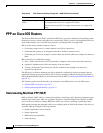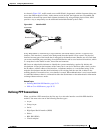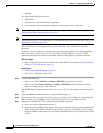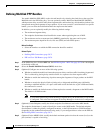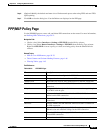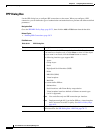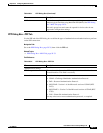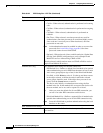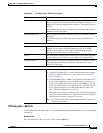
59-72
User Guide for Cisco Security Manager 4.4
OL-28826-01
Chapter 59 Configuring Router Interfaces
PPP on Cisco IOS Routers
• Multilink
You cannot define PPP connections on:
• Subinterfaces.
• Serial interfaces with Frame Relay encapsulation.
• Virtual template interfaces defined as Ethernet or tunnel types (serial is supported).
Note You cannot configure PPP on serial interfaces that are configured for Frame Relay encapsulation. See
Defining Basic Router Interface Settings, page 59-3.
Note Deployment might fail if you define PPP on a virtual template that is also used in an 802.1x policy. See
Defining 802.1x Policies, page 61-4.
You can select one or more authentication protocols and define when authentication should be
performed.
In addition, you can configure the authentication and authorization methods to use when performing
AAA on a remote security server. You can either define a default method list to use for all PPP
connections on the device or define a customized method list that applies to a specific connection.
Before You Begin
• Make sure that the device contains an interface on which PPP can be configured. See Basic Interface
Settings on Cisco IOS Routers, page 59-1.
Related Topics
• Defining Multilink PPP Bundles, page 59-74
• PPP on Cisco IOS Routers, page 59-70
Step 1 Do one of the following:
• (Device view) Select Interfaces > Settings > PPP/MLP from the Policy selector.
• (Policy view) Select Router Interfaces > Settings > PPP/MLP from the Policy Type selector.
Select an existing policy or create a new one.
The PPP/MLP page is displayed. See Table 59-30 on page 59-75 for a description of the fields on this
page.
Step 2 Click the Add button beneath the table to display the PPP dialog box.
Step 3 In the Interface field, enter the name of the interface or interface role on which you want to define the
PPP connection, or click Select to select an interface role from a list or to create a new one.
Step 4 (Optional) On the PPP tab, define authentication for the PPP connection:
a. Select one or more authentication protocols.
b. Select one or more authentication options. These options determine when to perform authentication
(callin, callout, and callback), whether to use one-time passwords, and whether to allow a mobile
station in a PDSN configuration to receive Simple IP and Mobile IP services without using CHAP
or PAP.



